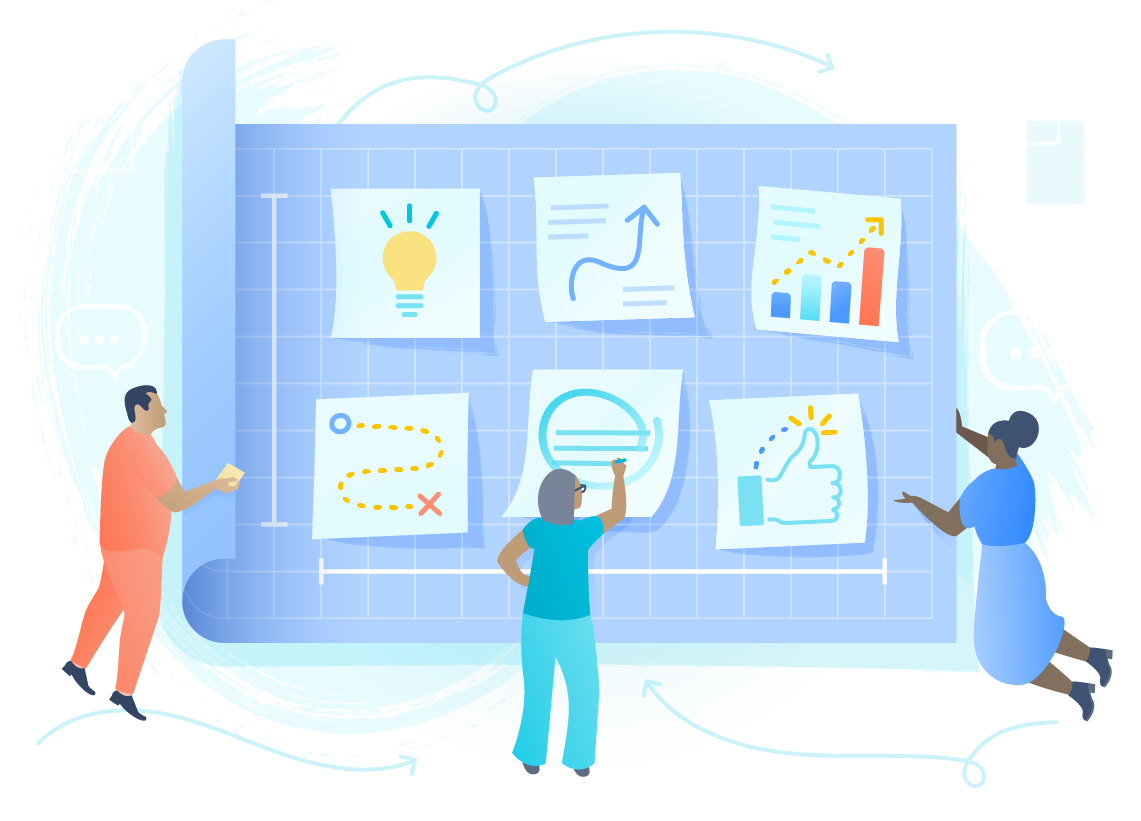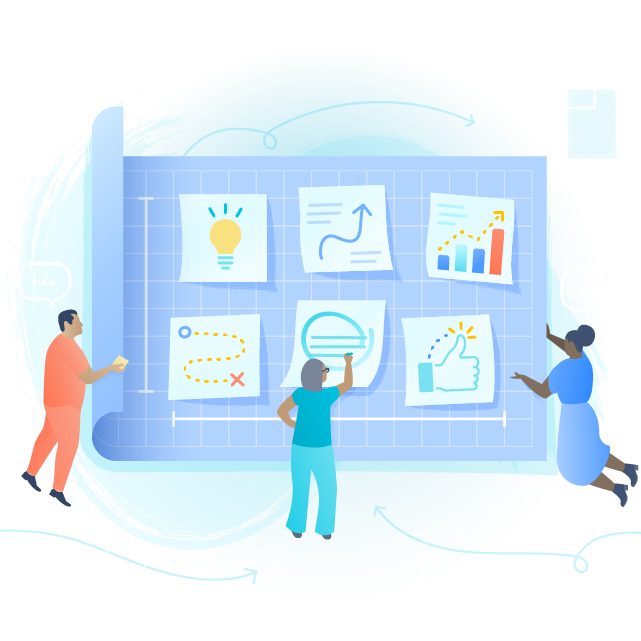What you'll need
Remote
Video conferencing with screen sharing
Digital collaboration tool
In-Person
Butcher paper or whiteboard
Colored markers
Colored post-its
Magazines or other images
Scissors
Sticky Tack
Optional templates
Atlassian Templates
Instructions for running this Play
1. Prep 10 MIN
Prepare a shared document for your team to collaborate ahead of time. Set a time that you will meet together and let everyone know that there will be homework a few days ahead of meeting.
Use a digital collaboration tool such as Trello or Confluence to detail some brief background notes on how you’ll measure your team’s success. This will be a key reference to keep your team on track for the scope of your brainstorming.
- Company mission
- Company values
- Business outcomes and expectations for your team to achieve and by when
- Customer personas
Put your vision statement at the top!
A vision details the future your team aspires to create. You can extrapolate this out to the department or organizational level. It should be larger than the business goals and should paint the picture of what success looks like. For example, Ben & Jerry's vision is "We make the best possible ice cream in the best possible way."
A vision differs from a mission statement, which defines the organization’s business, its objectives, and how it will reach these objectives. Ben & Jerry's uses their vision to break off into three core missions: a product mission to make fantastic ice cream for its own sake, an economic mission to manage the company for sustainable financial growth, and a social mission to use the company in innovative ways to make the world a better place.
This exercise is centered around building empathy for your customers in really clear detail. Start off by better understanding your customer personas: run our Empathy Mapping Play followed by generating a Customer Journey Map to delve deeper. You can also use this template to kickstart persona creation.
TIP: Seeing is believing
Visualization has been proven to activate the same neural pathways in your brain as actual performance and has even been utilized by sports psychologists to improve outcomes of athletes. Painting a vivid picture is like your brain’s mental practice for success. The more vivid you can be the better.
2. Outline the goal 5 MIN
Set up a workspace—either a collaborative page in Trello for hybrid work or a standing easel in person—with the prompt question:
It is [period in the future] and we have achieved [our goal]. What does it look like?
Example: It is 2030 and Confluence is the best tool for all teams to collaborate. What does it look like?
You can use our Trello template for an easy start.
To find the right time horizon to use, consider the degree of impact you want to have or the level of your goal’s complexity. For a company or department-size vision, three to five years is ideal to start. Aim for 10 years for a really large-scale vision. For a team-level vision you might focus within one to three years for normal impact, or five years for larger complexity.
3. Be specific 10 MIN
As a team, you want to really understand the potential unique value proposition of your work. You are looking to create empathy with your customers. Think holistically when planning your goal, starting with impact, but narrow the focus down to the customer experience. Being specific through visualization techniques is like a dress rehearsal for your team’s future success.
Create a key on your board with a list of these thought-starters to inspire your team’s ideas.
Senses:
- Touch
- Hearing
- Sight
- Smell
- Taste
Context:
- Perspective
- Emotion
- Environment
- Task
- Timing
Create a column for each persona in order to imagine this future from a few different perspectives. Really paint the picture of what the future looks like for different people impacted by your work.
Add a few examples for each persona before sharing the board with your team. Their homework is simply to let the creative juices flowing. Encourage them to save some images that tell the story of success to share live when you meet.
Example persona: Customer service and executives.
Example entry: A customer service agent rides their bike in the sun to the local coffee shop and updates a Confluence page on their phone while sipping their hot coffee before heading back to their home office for the day.
TIP: Done is better than perfect
Every step in this process can be expanded. You could work for months just on building out personas! Don’t get too caught up in going through the perfect process, and instead focus on generating shared understanding with your team to a level of fidelity that will get you all moving in the same direction. It’s better to catch misalignment early than only share out your vision when it’s significantly harder to pivot.
4. Paint the picture 15 MIN
The day of the session has come! Open the meeting by reminding the team of the importance of a vision, where they can find the key of thought-starters, and that no ideas are wrong. Prompt your team to be as specific as possible to create a compelling vision of the future. There doesn’t have to be a picture attached to every idea, but it will certainly help.
Have all team members contribute ideas to the workspace, silently and synchronously, for 15 minutes in a speed round.
5. Share back 15 MIN
Ask each team member to speak to their thinking behind one of the ideas they put on the board.
Leave the board ‘open' for 24 hours for team members to submit more ideas asynchronously as they think of them or do some minor research. You'll be surprised how many more ideas flow once the team has taken time to think through the vision and expand on the input given during the meeting.
6. Consolidate 15 MIN
The next day, let your team know that you are ‘closing’ the workspace. Start to consolidate common ideas into ‘themes’. Label these themes and write up a brief description of each.
7. Regroup 30 MIN
As the facilitator, regroup with your team to present the key themes you noticed, calling out a handful of ideas per theme as you do. Ask at the end whether you misinterpreted anyone’s ideas. Then work together to identify which themes feel actionable and relevant. The vision, for example, may be "to be the best marketing team in outer space," but is it realistic? Seek to refine the themes in specific and manageable ways.
Ask each team member to highlight one of the photos they didn’t put up and speak to why it resonates with them as part of their team’s vision. This is a great opportunity to build a shared understanding of direction with your team, and create a North Star to keep each other on track as your projects proceed.
Follow-up
Build a finalized and polished vision document in Confluence for your team and stakeholders. Start with just the themes, and then flesh the page out with images, customer quotes and research as your project matures.
The purpose is to inspire, communicate, and create a document for posterity of other teams and new-comers to onboard quickly to your team’s vision.
If it comes to light that your team and another team in your network have different ideas of the future—great! Now is a perfect time to spin up a DACI and get your leadership to agree on where the company is heading, before you head too far down the wrong path. Finally, once the initial vision is created, add it to your Team Poster.
Next, move onto fleshing out an Experience Canvas and running the Team goals, signals, and measures Play to start the process of turning your Vision into Strategy.
Stay up to date
Get the latest Plays and work life advice when you sign up for our newsletter.


